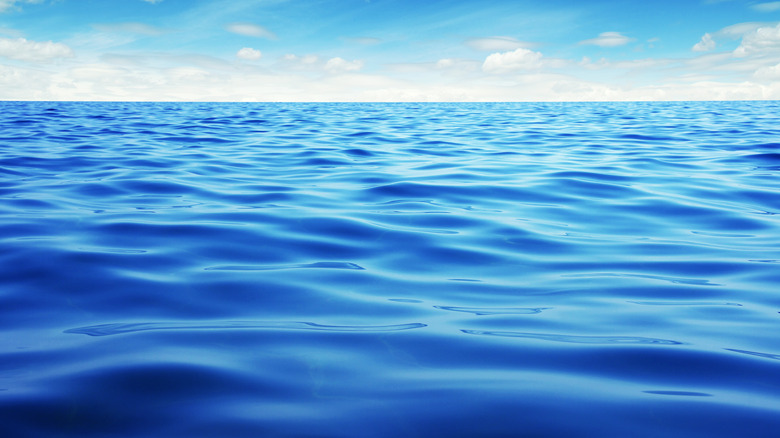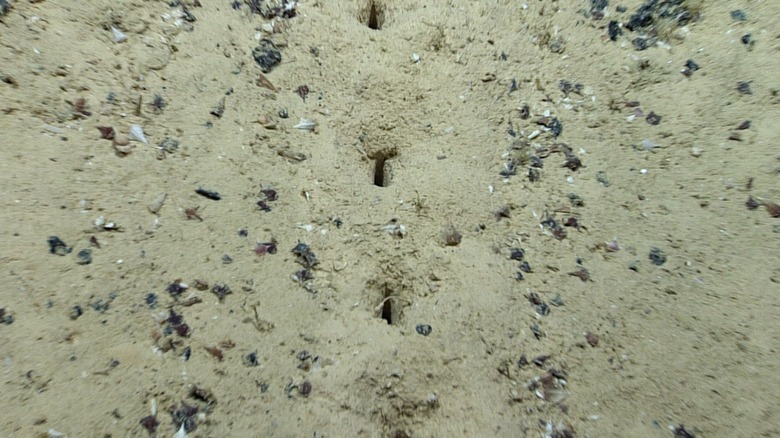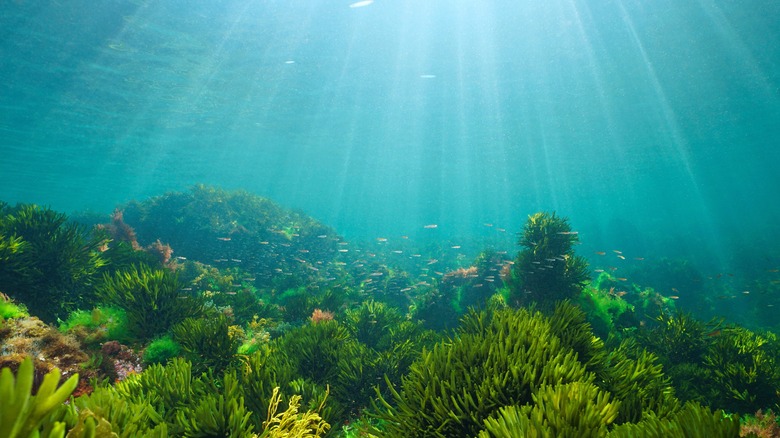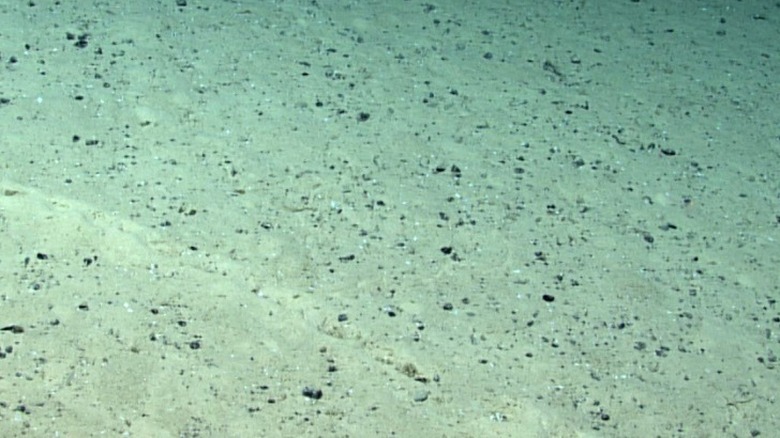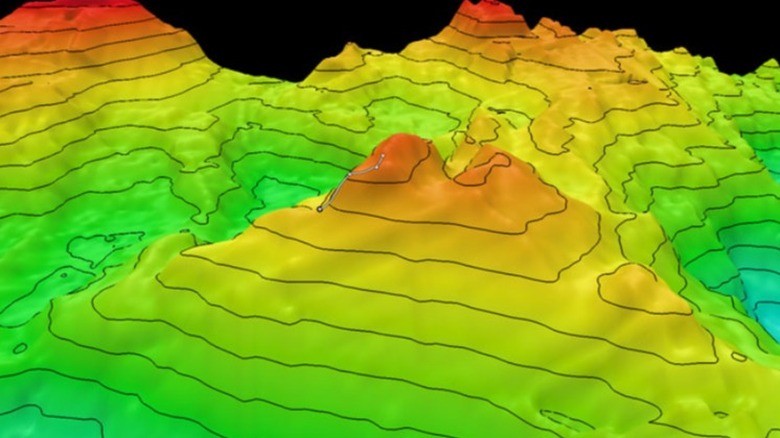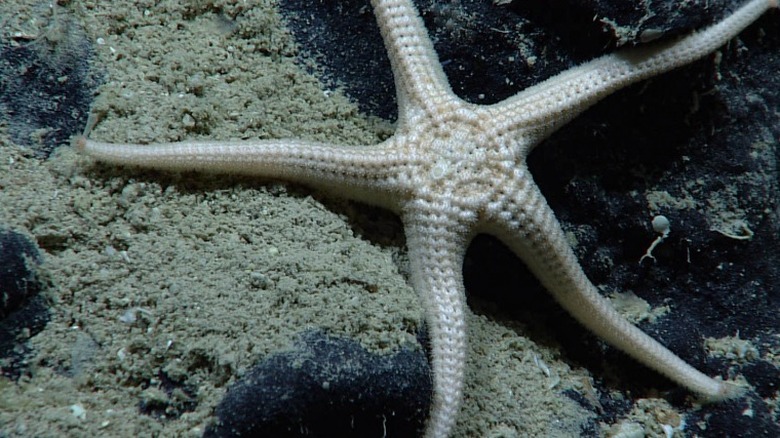The Biggest Theories On What Made 'Alien' Holes On The Ocean Floor
The depths of the world's oceans hold many unsolved mysteries. Now, you can add one more: Who or what created the near perfectly repeated patterns of small holes on the ocean floor? Researchers who spotted them in the mid-Atlantic Ocean near the Azores in July of 2022 want to know — and they'd like the public's help.
Scientists with the National Oceanic and Atmospheric Administration's Okeanos Explorer vessel initially discovered a dozen sets of holes about 1.6 miles underwater, according to The New York Times. About a week later, they found four more sets about 300 miles away from the first ones. Spaced about 4 inches apart, they occurred in nearly straight lines in the sediment on the ocean floor. On NOAA's Facebook page, researchers describe them as "almost human-made, the little pieces of sediment around the holes make them seem like they were excavated by ... something." So just what is that something? In a news release, the agency coined the perplexing find "The Case of the Mysterious Holes on the Seafloor" and asked the public to weigh in on Twitter and on Facebook with their own theories.
It wasn't the first time the mysterious holes were seen
Turns out, the 2022 sighting was not the first time the oddities were seen. Some 18 years earlier, back in 2004, NOAA scientists first spotted mysterious depressions in the ocean floor while diving in the same area, according to Live Science. Back then, the scientists thought they could have been caused by some type of organism that either lived in the holes or moved about in them. But if the organisms existed, they did their work in private. No one ever witnessed them creating the holes, making it impossible to say with any certainty what actually caused them.
Fast forward to 2022, and researchers attempted to look into the holes with the help of a remotely operated vehicle, according to NOAA. That endeavor wasn't successful. Scientists also suctioned sediment from the depressions in their search for clues, and they collected a water sample to look for DNA that might provide the identity of any creatures living in or around the formations. So far, nothing.
Putting the question out there
The mystery of the lines of small, oblong holes fascinated both researchers and the public. Once NOAA put out its request for people to weigh in on the matter on social media, they did. Hundreds of people posted their ideas on Facebook and Twitter. Some of their responses were tongue-in-cheek, but others had clearly spent some time pondering the mystery.
The responses included ants, crustaceans, and worms. Others hypothesized the culprit was a "really big gram cracker," a "starfish doing cartwheels," or a "swordfish sharpening its bill." Some suggested it could be a buried cable or some sort of perforated pipe; others suspected gunfire or a company searching the area for resources that they hadn't received the proper permits for. And still others surmised the depressions weren't made by creatures or humans or anything manmade at all but instead came from deep in the earth: an underwater volcano, a fault line, or escaping gases.
What really made the mysterious holes in the ocean?
Because each hole in the linear patterns had small piles of sediment around its opening, NOAA deep-sea biologist Mike Vecchione said that might indicate something pushing up and through the sediment, according to As It Happens. He believes that something is most likely a burrowing animal. "I think what's happening is that there's an animal burrowing in the sediment, under the surface of the sediment, and periodically punching chimneys up to where the water is, maybe to get clean water circulating through its burrow," Vecchione told As it Happens.
But because scientists on the expedition didn't have the exact answer, Vecchione hoped that putting the pictures on social media might reach someone with specialized knowledge who could provide the answers the researchers had been searching for. So far, Vecchione says he's received many guesses but no firm answers. "I'm thinking that this truly is something that nobody knows the answer to," he told As It Happens.
Why researchers don't think the holes are manmade
Canadian marine geologist John Jamieson says he's never seen anything like it, according to CBC Radio. He says the shape of them — almost symmetrical with right angles — seems unlike anything an animal would make, adding that typical burrowing animals usually create a more spherical shape. Still, he does believe that's the answer.
NOAA biologist Mike Vecchione says previous discoveries of certain tube-like fossils in the ocean's sediment may help support his burrowing-animal hypothesis. "I think that is an argument against any kind of man-made explanation for this," Vecchione told CBC Radio. He said he's not sure if the animal could belong to a species yet undiscovered. That wouldn't be surprising given that scientists estimate a mere 9% of ocean species have been classified, according to NOAA. The agency says no one knows how many species live in the world's oceans and that over 80% of the ocean is unmapped, unexplored, and unobserved.
What else the Okeanos Explorer expedition found
So maybe the mystery involving the unusual cylindrical holes on the ocean floor will have to wait for another day. But the Okeanos Explorer vessel did gather a lot of data and captured beautiful images of undersea life over its four-month expedition in 2022. The mission set out to map and survey a large swath of the Atlantic from Newfoundland to the Azores to Puerto Rico, according to the National Oceanic and Atmospheric Administration. In particular, Okeanos researchers wanted to understand more about the largely unexplored Mid-Atlantic Ridge (MAR), a 10,000-mile-long underwater mountain range that's the longest of its kind on the entire planet. Researchers also wanted to know more about biodiversity in the area and examine the sponge and coral populations and geothermal vents. And they hoped to use what they learned to increase public awareness about issues affecting the ocean.
Still, NOAA biologist Mike Vecchione says he's a little disappointed that scientists don't have the answer to the question of what created the holes, according to The New York Times. He says that some day, they'll figure it out.
